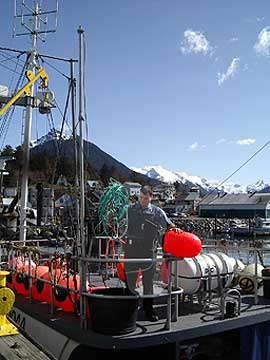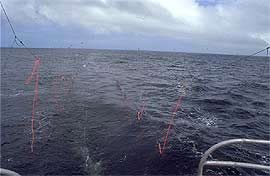Seabird Bycatch Reduction Program - Guide for Alaska Fishermen
Seabird Avoidance Gear and Methods:
Information for Alaska Fishermen
Seabird Bycatch
Regulations
- Current Regulations - Effective January 17, 2008
- 72 FR 71601, December 18, 2007. Final rule to revise the seabird avoidance measures for the Alaska hook-and-line groundfish and halibut fisheries. Effective January 17, 2008.
- News Release: December 18, 2007
Related Documents
- Final Environmental Assessment/Regulatory Impact Review/Final Regulatory Flexibility Analysis for a Regulatory Amendment to Revise Regulations for Seabird Avoidance Measures in the Hook-and-line Fisheries off Alaska, October 2007
- 69 FR 1930, January 13, 2004. Final rule to revise regulations requiring seabird avoidance measures in the hook-and-line fisheries off Alaska. Effective February 12, 2004.
Who Must Use Seabird Avoidance Measures?

NMFS Enforcement Officer Wynn Carney inspecting seabird avoidance gear in Sitka. Photo: NOAA Fisheries
- Pacific halibut in the Individual Fishing Quota (IFQ) and Community Development Quota (CDQ) management programs (0 to 200 nautical miles (nm)),
- IFQ sablefish in EEZ waters (3 to 200 nm), waters of the State of Alaska (0 to 3 nm), and groundfish (except IFQ sablefish) with hook-and-line gear in the U.S. EEZ waters off Alaska (3 to 200 nm).
- Other than noted above, vessel operators using hook-and-line gear and fishing for groundfish in waters of the State of Alaska must refer to seabird avoidance measures in State regulations. See 5AAC 28.055.
- Exemption: Operators of vessels 32 ft (9.8 m) LOA or less using hook-and-line gear in IPHC Area 4E in waters shoreward of the EEZ are exempt from seabird avoidance regulations.
What are the New Seabird Avoidance Requirements?
- Standards for streamer lines must be used on hook-and-line vessels greater than 26 ft (7.9 m) and less than or equal to 55 ft (16.8 m) fishing in the EEZ (see the regulations for the specific standards).
- Seabird avoidance requirements are no longer required for all hook-and-line vessels fishing in Prince William Sound (NMFS Area 649), the State waters of Cook Inlet, and Southeast Alaska (NMFS Area 659) EXCEPT for certain areas in the inside waters of Southeast Alaska.
- The 3 exception areas are:
- Lower Chatham Strait south of a straight line between Point Harris (latitude 56° 17.25 N.) and Port Armstrong,
- Dixon Entrance defined as the State groundfish statistical areas 325431 and 325401, and
- Cross Sound west of a straight line from Point Wimbledon extending south through the Inian Islands to Point Lavinia (longitude 136° 21.17 E.).
- Maps of these areas
- The Seabird Avoidance Plan is no longer required.
- The requirement to use one “other device” is removed.
- Vessels greater than 26 ft (7.9 m) and less than or equal to 55 ft (16.8 m) may use discretion with seabird avoidance requirements when winds exceed 30 knots (near gale or Beaufort 7 conditions).
What Type of ‘Bird Scaring Line' Must be Used?

Streamer lines. Photo: Ed Melvin, WSGP.
The type of ‘bird scaring line' you are required to use depends on the area you fish, the length of your vessel, the superstructure of your vessel, and the type of hook-and-line gear you use (e.g. snap gear). See Table 20 and the actual regulations at 50 CFR Part 679.24(e)(2) for your specific requirements.
- Larger vessels [greater than 55 ft (16.8 m) length overall (LOA)] in the EEZ must use paired streamer lines of a specified performance and material standard.
- Smaller vessels [greater than 26 ft (7.9 m) LOA and less than or equal to 55 ft LOA] must use a single streamer line or, in limited instances, a buoy bag line. Required performance and material standards are now specified for smaller vessels.
- See Table 20 of Part 679
Is ‘Night-Setting' an Option as a Seabird Avoidance Measure?
No. Night-setting, the use of a line shooter, or the use of a lining tube (for underwater setting of gear) must be accompanied by the applicable seabird avoidance gear requirements as specified in the regulation.
Are Free Streamer Lines Still Available?
Yes. See the free Streamer Line web page for the nearest Streamer Line distribution center.
What Do I Do if I Accidentally Hook Birds While Hauling Gear and They Come Onboard Alive?
The new regulations continue to require that every reasonable effort be made to ensure that birds brought on board alive are released alive. The U.S. Fish & Wildlife Service (USFWS) says that these live birds should be released on site if they meet ALL of the following criteria:
- Bird can stand and walk using both feet.
- Bird can flap both wings and there is no apparent wing droop.
- Bird is alert, active, holds its head up and reacts to stimuli.
- Bird is not bleeding freely.
- Wing and tail feathers have not been lost and are in good condition.
- Bird is waterproof (water beads up on feathers).
If the bird does not meet all of these criteria, then see Appendix 2 of the USFWS Biological Opinion on the Effects of the Total Allowable Catch-Setting Process for the Gulf of Alaska and Bering Sea/Aleutian Islands Groundfish Fisheries to the Endangered Short-tailed Albatross (Phoebastria albatrus) and Threatened Steller's Eider (Polysticta stelleri), September 2003, for details on how to care for the bird.
When Are the New Regulations Effective?
The new regulations were effective January 17, 2008, 30 days after the publication of the final regulations in the Federal Register (72 FR 71601, December 18, 2007).
Additional Information
- Regulations: Seabird Avoidance Gear and Methods
- Incidental Take Limit Established
- USFWS's Encounter Form: for the Short-tailed Albatross
- Free Streamer Lines
- Streamer Line Schematic (external link)
- Off the Hook: A Video for Longline Fishermen (external link)
- StopRats.org: Rats aren't good on your boat or on seabird colonies! (external link)
- Seabird Bycatch Estimates by Species Groups
- The Short-tailed Albatross
- Seabird/Fishery News
- Additional Seabird Websites
The Small Business Regulatory Enforcement Fairness Act requires agencies to publish one or more Small Entity Compliance Guides for each rule or group of related rules for which the agency prepares a Final Regulatory Flexibility Analysis. The Small Entity Compliance Guide is to be written in plain language and explain the actions a small entity must take to comply with the rule or group of rules. NMFS has prepared this webpage, "Seabird Bycatch Information for Alaska Fishermen" as a Small Entity Compliance Guide for the seabird avoidance measures. For the exact regulatory language, refer to Title 50 of the Code of Federal Regulations part 679.24(e).